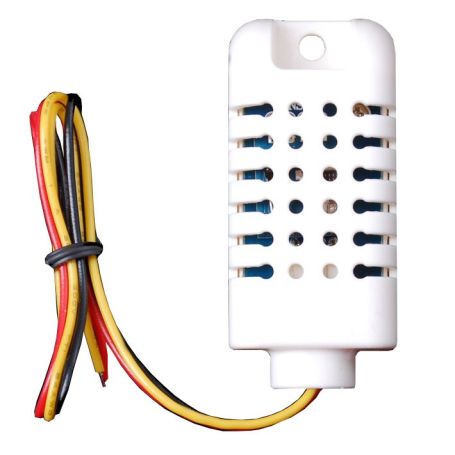[T] - DHT22 (AM2302) senseur humidité - température
The AM2302 is a DHT22 humidity-temperature sensor with wires and large plastic case.
Payments are secured by LyraCollect, a French payment collection company.
It is possible to delivered to your home, to a pick-up point or picked up by appointment at MCHobby
We prepare, pack and ship your orders with great respect and care.
Description
The AM2302 is a DHT22 version with wires, contained in a plastic body. It is a basic and affordable temperature and humidity sensor. It uses a capacitive humidity sensor and a thermistor to measure the surrounding air and produce a digital signal on a data pin. This sensor doesn't require any analog input.
It is very simple to use but nevertheless requires precise time management to obtain the information (see tutorial section). The only real disadvantage of this sensor is that you get a new measurement every 2 seconds. So, using the library, the read value can be two seconds old.
Compared to the DHT11 model, this sensor is more accurate and operates over a wider temperature/humidity range. It is also bigger and a bit more expensive than a DHT11.
Connection
Simply connect a 3-5V power supply on the red wire. The yellow wire corresponds to the data pin and the black wire to Ground (GND).
Even if it uses a single wire to send the data, this sensor doesn't use the Dallas One Wire protocol! If you want to use several sensors, each of them must have its own data pin!
The sensor is already equipped with a 5.1K resistor connecting VCC and DATA. So you will not need to add a pull-up resistor.
Technical details
- Affordable
- 3 to 5V for power and I/O
- 2.5mA max during conversion (during data acquisition)
- Suitable for a humidity reading of 0-100% (with an accuracy of 2-5%)
- Suitable for temperature reading from -40 to 80°C (with an accuracy of ±0.5°C)
- Sampling at 0.5 Hz (once every two seconds)
- Case: 27mm width x 59mm length x 13.5mm thickness
- 3 wires of 23cm long
- DHT22 data sheet
Tutorial
- Our tutorial for using DHT22 in French for Arduino
- AdaFruit offers a tutorial in English on the use of DHT22 with Arduino.
- AdaFruit offers a tutorial in English on the use of DHT22 with Raspberry Pi.






